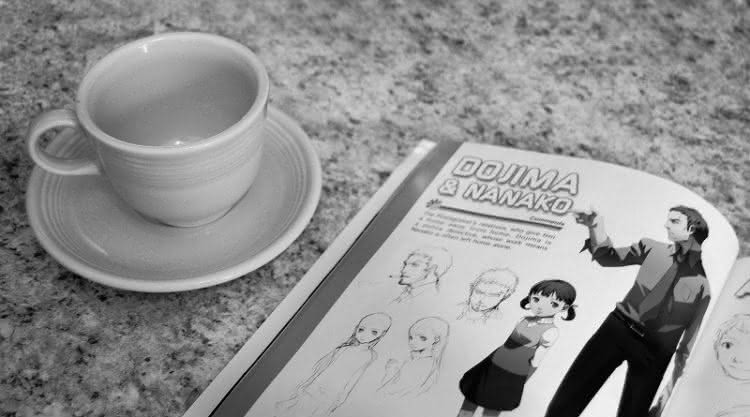Before we launched The New Leaf Journal, I spent time drafting articles for when the site would finally go live. The very first article that I drafted, on August 9, 2018, was about a scene from one of my all-time favorite video games, Persona 4. Specifically, it was about a scene in Persona 4 involving giving coffee to young children. Like most of the early articles, I held it in reserve. However, on August 13, 2020, Persona 4 Golden, was ported to computers for Steam with much fanfare. With my article on the Persona 4 coffee and children scene now being timely, I decided to refine my nearly-two-year-old draft for publication.

Introduction 〜 Coffee and Children Conspiracies
During my elementary school days, I heard many adults moralizing about the supposed horrors that would ensue from children drinking coffee. Often, their own sugar-addled children would parrot their parents’ views, suggesting that coffee could even stunt growth. These claims struck me – then only a seldom coffee drinker – as dubious.
I am no longer in the loop about views on coffee consumption for children. I will venture from my observations of the goings on outside of Starbucks around New York City that the number of adherents to coffee-children conspiracy theories has waned over the years. But the current views on coffee and children are not what prompted me to write the instant article. Instead, I was motivated by the memories of my youthful days.
What is Persona 4?
Persona 4 is a magnificent Japanese role playing video game that has been released in three iterations. It was originally released for the PlayStation 2 in Japan, and later in the United States, in 2008. A re-mastered version was released for the PlayStation Vita in 2012. The re-master was released for the PC in 2020. I played both the PlayStation 2 and Vita versions, the latter over several months with Victor. But I first experienced the coffee and children scene I write about here sometime during 2011, playing the original PlayStation 2 version.
I will provide a short introduction for those who are not familiar with the game. In light of its re-release for Steam, I offer a mild spoiler warning. This article contains no spoilers pertaining to the main plot of Persona 4. Accordingly, it is safe to read for those who are in the middle of their Persona 4 journeys or those who are considering playing in the future. With that being said, those who are either currently playing or plan to play may want to reach the event in question – level 4 of the Heirophant social link (see below) – before reading the rest of this article.
Social Links
The player-character in Persona 4 is a high school student who spends his time going about his day-to-day life while also fighting monsters inside a television-world. In the daily life segments of the game, the player character can befriend a number of classmates and individuals around the game’s town. Each associate corresponds to one of the Major Arcana of the Rider-Waite tarot deck (with a few spill-overs in the remake). These relationships are referred to as “social links.” The player-character develops social links by spending time with the characters, and each link maxes out at level 10.
Our Social Link
The player-character lives with his uncle and his uncle’s daughter – Ryotaro Dojima (“Dojima”) and Nanako Dojima (“Nanako”) respectively. Dojima is a detective for the local police department. Nanako is a six-year old elementary school student. Dojima is the Heirophant social link and Nanako is the Justice social link. Dojima’s wife and Nanako’s mother was killed several years prior to the start of the game in a hit-and-run car crash.
The instant article is about the level-four social link event for Dojima, in which Nanako plays an important part.

The Social Link Event
The scene begins in Dojima’s kitchen one evening. Dojima offers the player instant coffee. The player is then prompted to choose from one of four options for how he likes his coffee. The player’s choice does not change the course of the event.
After the player decides how he takes his coffee, Nanako enters the scene to inform her father that the news broadcast is starting. Nanako then noticed that her father was preparing coffee: “Oh, coffee! Can I have some?” she asked earnestly.
More than nine years after playing the scene for the first time, I remember thinking back to the views I heard about coffee when I was not much older than Nanako. My curiosity was piqued. How would Dojima respond to Nanako’s requesting coffee in the evening? Would he scold her because it was a school night? Tension hung in the air. I bravely pressed forward by advancing the dialogue.
How Do You Like Your Coffee, Kid?
“Sure thing” Dojima responded to his daughter with no hesitation. “Plenty of sugar and cream, right?” he asked his blessed daughter. Nanako, with a radiant smile, responded enthusiastically in the affirmative.
Interlude: The Greatest of Video Game Heroes
What is a video game hero? Is it Mario always searching for Princess Peach in another castle? Sonic jumping on robots to rescue little critters? The silent protagonists of the Persona games saving the world while deepening bonds? These are all compelling heroes, but they all pale in comparison to Ryotaro Dojima. Even if Dojima saved a princess while becoming best friends with hundreds of critters he rescued from robots, he would not be more heroic than when he gave his elementary-school-aged child coffee on a school night.
Dojima is the greatest game hero and the greatest 2D dad. I choose to assume the coffee was not decaf. The Dojima in my pantheon is above such plebian things. He is not, however, above instant coffee.
Resuming the Story 〜 He’s Industrious Too
Not content with merely being the world’s leading enabler of night-time coffee consumption for school children, Dojima instructs the player to watch television while he makes coffee. The player is prompted to either offer to help Dojima or thank him. The choice does not meaningfully affect the course of the event. I of course offered to help Dojima prepare the coffee. To be sure, I would have done anything Dojima asked me. I would have marched by his side to recapture Constantinople.
Acute Melancholia
Dojima, however, had no time for my offer. “Making the coffee is my job around here,” Dojima stated. He explained that when he married his late wife, Chisato, his mother-in-law told him that the only thing he had to do around the house was make the coffee. She added, he recounted, that “nobody else can do it.” Dojima followed those instructions, and over time, he stated that making coffee became something of a habit. Then, in a melancholic moment, Dojima ruminated on his lingering guilt about his self-perceived powerlessness. Dojima said, bitterly, “[t]his is the only promise I can really keep these days…”
With that, the player retires to join Nanako in the living room while Dojima makes the coffee. The scene ends, and the game moves to the next day.
More than Persona 4, Coffee, and Children
When I first went through the scene in real time, my attention was initially arrested by the novelty of giving coffee to a young child on a school night. The scene quickly turned to weightier issues.
Dojima’s coffee-making routine began as his one chore around the house. Over time, that chore became a “habit” that persisted even after his wife was killed. The act itself, like coffee with milk and sugar, was bittersweet for Dojima. He smiled as he recalled promising his mother-in-law that he would take sole responsibility for making coffee around the house.
When Dojima grimaced, he contemplated his own deep-seeded feelings of inadequacy. His wife was dead. Nanako did not have a mother? Was someone who as impotent as he enough to raise his daughter? He was a detective, yet the mystery of who killed his wife was unsolved. In light of these issues weighing on Dojima, he wondered whether in the end making coffee was, in fact, all that he was good for.
From this, we see that Dojima’s coffee was equal parts sweet and bitter. In the former sense, he was joyfully honoring the promise he had made when he married Chisato and the brief time his family was whole. In the latter sense, he began to view coffee duty solemnly, perhaps as an inadequate form of recompense for his perceived short-comings.
Missing the Forest Through the Coffee Leaves
Dojima, perhaps introspective to a fault, may have failed to contemplate the most important moment in the scene. I initially argued that the most important part of the scene was his decision to give coffee to a child on a school-night. That was perhaps not quite right. The most important part of the scene was, in fact, Nanako’s joy and her unrestrained gratitude to her father. Dojima wallowed in self-condemnation and his belief that he had not been enough for his late wife and was not enough for his daughter. Nanako, alive and well, loved her father more than anyone in the world. Dojima was focused on what was lost – and what he felt he was responsible for losing – but perhaps not on what he could still do for himself and his daughter.
The Persona 4 coffee and children scene includes all the major themes of Dojima’s and Nanako’s story. It depicts the obvious love they share, and Nanako’s gratitude. At the same time, it shows Dojima’s struggles to see the present through the clouds of his past. Those clouds, ever present, foreshadow the impending struggles of Dojima and his daughter to see and understand the other.
In keeping with my promise to avoid express spoilers, I will cut my analysis of Dojima and Nanako short here today. I encourage all – avid video game players and neophytes alike – to try Persona 4 Golden on PC. Watching the respective story arcs of Dojima and Nanako, and the collective culmination of their story, is one of the highlights of a magisterial JRPG.
Final Thoughts
In one scene, we see the warmth of a small and awkward family on a calm evening and the somber musings of a pensive father unsure of himself as he charts an uncertain path with his young daughter and, temporarily, his nephew. The scene grabbed my attention with the coffee-and-children drama, and held it with Dojima’s internal drama. In these ways, Dojima’s level four social link event is an example of what video games, well-conceived and well-written, can be in their best form.
Thanks to the game’s most recent re-release, more people will have a chance to see the story of Dojima and Nanako for themselves. That is more than worth a coffee with cream and sugar – albeit, I do prefer half and half.